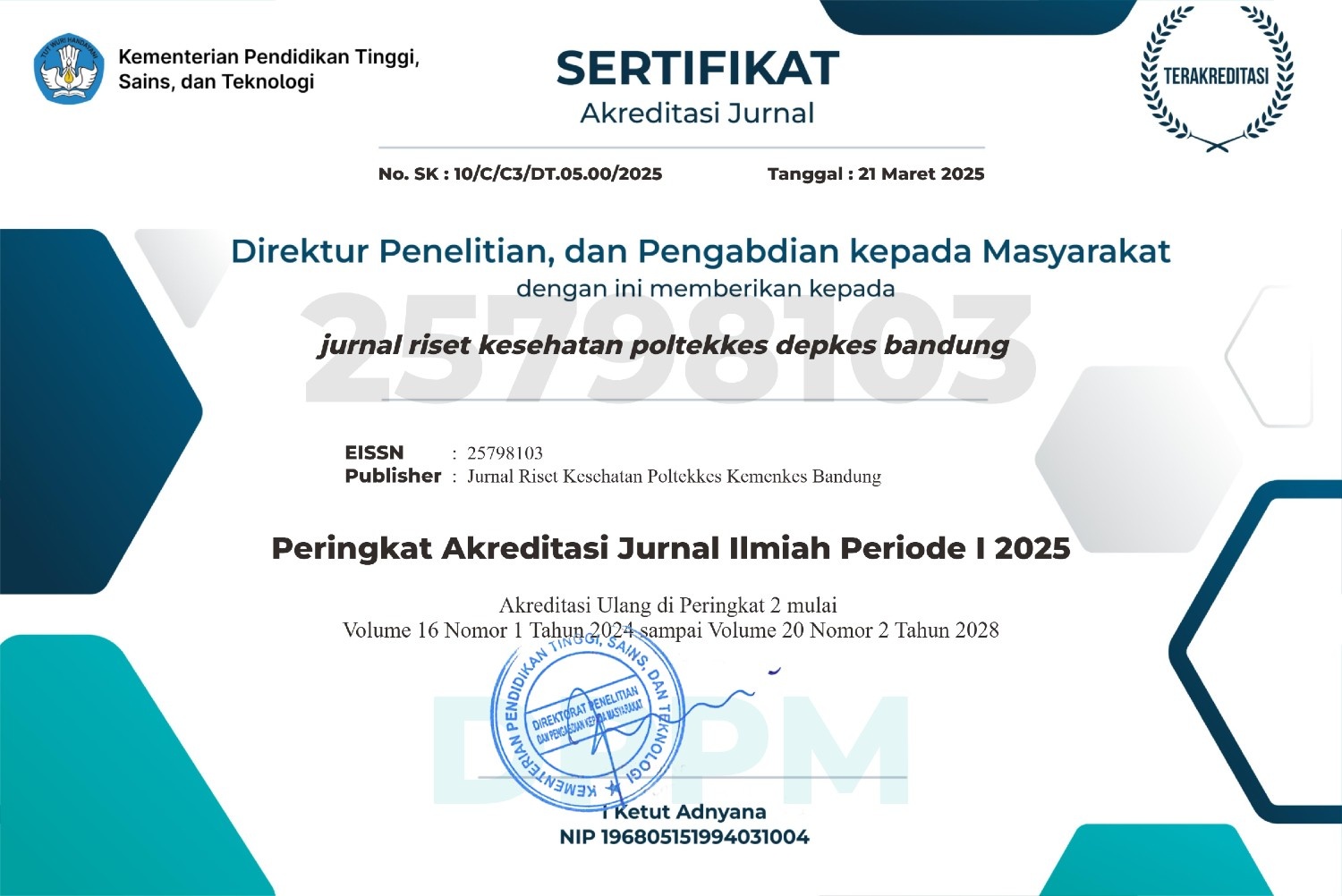PENGUKURAN INDEKS OVITRAP TERHADAP POPULASI TELUR Aedes sp.
DOI:
https://doi.org/10.34011/juriskesbdg.v15i2.1933Keywords:
Ovitrap Index, Aedes sp.Abstract
The mosquito Aedes sp. is capable of carrying a number of diseases, including dengue fever (DBD). One setting where the DBD sickness could spread is an educational one. Naturally, the government's PPKM policy reduces the effectiveness of student activities on campus during a pandemic like this one, which causes the cleaning staff to work less diligently to maintain this building. The purpose of this study was to ascertain the percentage value of the Ovitrap index (OI) in relation to the presence and density of Aedes sp. mosquitoes in the campus environment of Politeknik Piksi Ganesha Bandung. Counting IO and watching Ovitrap are the research methods used. Every building on campus has Ovitrap installed, both outside and interior. According to the study's findings, out of the 28 Ovitrap that were installed at Politeknik Piksi Ganesha Bandung, 12 of them were positive, making up 42.85% of the total Ovitrap index. With a score of 4 (IO ≥ 40%) on the Ovitrap index criterion for research locations, the area is considered to have a high potential for DBD disease insecurity. Further research is required in relation to the free number of the flick and identification of Aedes species found in the campus area. Subsequent studies must focus on labeling and socialization of ovitrap deployment.
Downloads
References
Nadhiroh S.A, Cahyati W.H, Siwiendrayanti A. perbandingan modifikasi ovitrap tempurung kelapa dan ovitrap standar dalam memerangkap telur Aedes sp : Higeia Jounal Of Public Health. 2018 : 137-148.
Sandra T, Sofro M.A, Suhartono S, Martini M, Hadisaputro S. faktor-faktor yang berpengaruh terhadap kejadian demam berdarah dengue pada anak usia 6-12 tahun di Kecamatan Tembalang . 4, s.l. : Jurnal Epidemioogi kesehatan Komunitas, 2019, Vol. 1.
Aminah. Epidemiologi kesehatan komunitas Jumlah penderita DBD di Kota Bandung. Bandung :2019.(https://sehatnegeriku.kemkes.go.id/baca/umum/20201203/2335899/data-kasus-terbaru-dbd-indonesia/)
Yustin A.S, Sorisi A, Pijoh V.D. indeks jentik dan pupa nyamuk aedes sp Di wilayah Kombos Timur Kota Manado . Manado : kandidat skripsi fakultas kedokteran Universitas Sam Ratulangi Manado, 2016.
Mawardi M, Bursa R.studi perbandingan jenis sumber air terhadap daya tarik namuk aedes aegypti untuk bertelur : jurnal serambi engineering , 2019:Vol. 2.
Hidayah W.N, Hidayat J.W, Rahadian R. 2013. Ovitrap bermedia air rendaman jerami pendahuluan demam berdarah dengue (DBD). Jurnal Biologi, Volume 2 No.4, Oktober 2013. Hal. 25-34.
Nadhiroh S.A, Cahyati W.H, Siwiendrayanti. Ovitrap standar untuk memerangkap aedes sp : higeia journal of public health, 2019: 125-127.
Astuti R.D, Ismawati, Siswanti L.H, Suhartini A. sebaran vektor penyakit demam berdarah di Kampus Universitas Islam Bandung : global medical & Health Commuication (GMHC), 2016: Vol. 2.
Subekti, wahyudi. Pengaruh berbagai konsentrasi ekstrak daun kluwek (pangium edule) terhadap mortalitas larva aedes aegypti sebagai sumber belajar biologi. Malang: Jurnal Stikes Ahmad Yani Cimahi, 2018.
Zulkoni. parasitologi. Yogyakarta : Muha Medika. 2011.
T, Fatmawati. Distribusi dan kelimpahan Populasi Aedes sp Di Kelurahan Sukorejo Gunung Pati Semarangberdasarkan Peletakan Ovitrap. Semarang : Life Science, 2014.
A.N, Azizah. Uji Mikrobiologi kandungan makanan jentik nyamuk Aedes aegypti . makassar : Universitas Negri Alauddin, 2016.
E.D, Ayunigtyas. 2013. perbedaan keberadaan jentik aedes aegypti berdasarkan karakteristik kontaniner di daerah endemis demam berdarah dengue . Semarang : skripsi 18-44.
Sumarni. 2016. identifikasi larva Aedes sp pada tempat penampungan air masyarakat di rw 0 kelurahan Pandaleu Kecamatan Kambu Kota Kendari Sulawesi Tenggara : poktekes kesehatan kendari.Vol. 2.
Arisanti, M., dkk. 2021. Kejadian Demam berdarah Dengue (DBD) Di Indonesia Tahun 2010-2019. Jurnal SPIRAKEL, Vol. 13, No.1, 2021: 34-41.
I.W, Supartha. Pengendalian terpadu vektor virus demam berdarah Dengue, Aedes Aegypti, Aedes albopictus. 2008.
Hidayati L, Hadi U.K , Soviana S. kejadian demam berdarah dengue di kota Sukabumi bedasarkan kondisi iklim. Sukabumi : jurnal serambi engineering, 2017.
Kemenkes RI. DBD Di Indonesia Tahun 1968-2009. Buletin jendela epidemiologi. 2010 : Vol. 2.
Sembiring. Survey tempat perkembangbiakan dan kepadatan dalam kecamatan kaban jahe kabupaten Karo. Medan : Jurnal Politeknik kesehatan kemenkes Medan, 2018 : Vol. 3.
Garcia-Rejon J.E, Lorono-Pino M.A, Farfan Ale J.A. Mosquito infestation and denggue virus infection in aedes aedypti females in schools in merida. Mexico : The american jurnal of tropical medicine and hygiene. 2011: Vol. 3.
McMichael, Anthony J, Woodruff, Rosalie E. climate change and human health : Present and future risks. Lancet Journal 2006 Mar 11;367(9513):859-69.
Downloads
Published
How to Cite
Issue
Section
License
Copyright (c) 2023 JURNAL RISET KESEHATAN POLTEKKES DEPKES BANDUNG

This work is licensed under a Creative Commons Attribution-NonCommercial-NoDerivatives 4.0 International License.









